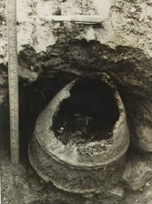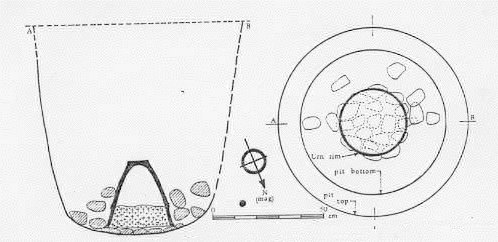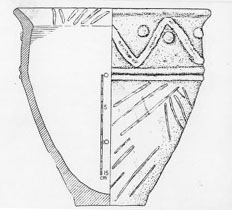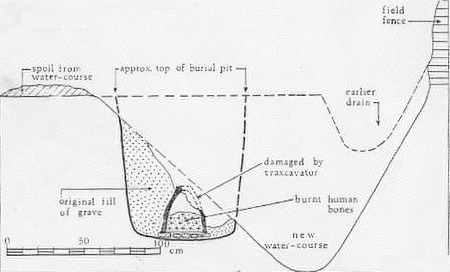Castlemagner has been inhabited by humans for at least the last 4000 years. An urn containing a full male skeleton dating back to 2000BC was dug up in a field between Banagh cross and Kippaugh cross in January 1975. It occured during the course of a land drainage project on the farm of Donal V. Lane. The burial was accidentally discovered during routine drainage work on Mr Lane’s farm, Coolnahane, Castlemagner.
The initial find was by Mr John Foley – Drainage Contractor Kanturk. The site of the grave lies adjacent to a double banked ringed fort now much over grown. This is one of the many ringed forts in the district. It seems clear that there is no connection between the grave and the fort, the position of both being a matter of chance. A few fragments of iron slag from the immediate vicinity of the fort puts it in the early Christian period (350-1200). During the war of 1916-21, digging was done within the fort to construct a safe place to store arms and fuel. In the process, the base of two kilns or furnaces were found. In general, the fort is in a good state of preservation and may well repay excavation.

The grave lies just east of the fort and just inside the townland boundary. The latter runs along the north side of the road with its southern fence almost touching the fort. This fence forms the boundary of the field in which the fort and burial is found. There is just enough room for the excavated drain to run between the fence and the fort. The water course is two meters wide at the top and one meter deep. The bucket of the excavator cut a slice off of the burial urn which was immediately noticed by Mr Foley. On realising what the find was, Mr Foley halted the work and notified University College Cork who dispatched Mr M J Kelly to organise a proper excavation of the site.
The bucket of the machine sliced part of the side and base of the urn (as seen in the photograph) but this caused little damage to urn or grave pit. By working through the spoil and by searching the fresh silt on the side and bottom of the new drain, several fragments of the damaged part of the pot were recovered and this has enabled the urn top be fully and correctly restored. The small missing area was filled with dental plaster. There is no evidence of any other similar burial in the area though such urns are known to occur in cemetery groups. Of the 70 examples that been investigated more than half are in cemeteries and all in either cysts or pit -graves as at Coolnahane.

The field in which was discovered has been frequently tilled which scattered the top soil and so cutting off the original top of the grave pit. When the grave was filled 1900-1600BC, all the soil could not fit back into it so a small mound should be close by. It is likely that tillage, by the people who lived in the ring fort, removed all traces of the little mound. As can now be reconstructed from what remains, the top of the pit was 885 cm high and the depth was 100 cm. The sides were cut almost vertically down to the nearly flat bottom of the pit which was 65 cm in diameter. The central area of the pit floor was then covered with a rough paving of irregular small stone slabs of uneven size. These were just thrown in and were of sandstone found in the area and were probably found in the spoil dug out of the grave pit.

The urn is 30 cm in diameter at the outside of the rim and 29 cm in height. This was placed mouth downwards on the central paving , the edge just showing outside the circumference of the urn. The pit was then back-filled with the dug out spoil put in. Also, located here and there around the urn are a few hand sized round boulders (of a river bed type). There was no organised protection for the urn and no protection for the burial-pit. The filling of the grave-pit had no fragments of burnt bone or charcoal (either inside the urn or surrounding it) that should have been gathered up with the burned bones from the ashes of the cremation pyre.

Some method was used to keep the bones together while the urn was lowered upside down over them. Because of the porous backfill of the grave-pit, the water level within the urn rose and fell frequently and fine pieces of silt were washed up into the urn and filled the interstices between the bone fragments. The fill around the urn was cleared to allow photographing, survey and drawings. The urn was then undercut and a flat support fixed under the urn to lift it with the bones undisturbed on to the field. It could be seen at this stage that the pot was cracked in a number of places. The urn is of the encrusted type and of bipartite profile, the two parts being divided by an applied ribthet that runs horizontally around the vessel.
It is interesting to note that the time that this prehistoric man’s remains were buried, the Jews were still in slavery in Egypt (1750BC).
In the late Bronze Age of Central Europe, a widespread group of ‘Urnfield cultures’ was characterised by cemeteries where the cremated remains of the dead were buried in urns, the same as the Urn found in Banagh Cross. Important Bronze Age sites were found in Terramare (Italy), El Argar (Spain), Leubingen, Buchau, Adlerberg (Germany), Unetice near Prague in Czechoslovakia, and at Otomani in Romania.
In the last quarter of the second millennium, circa 1200BC, Bronze Age Europe suffered an unexplained breakdown from which it never recovered. Archaeologists write of a ‘general systems collapse’. Trade was disrupted; cities were abandoned; political structures were destroyed. Waves of invaders descended on the remnants. Crete, having barely withstood a series of terrible natural disasters, had already fallen to the Mycenean Greeks, before Mycenae itself was destroyed. Within the space of a single century, many of the established centers passed into oblivion. Tribes overran the Aegean from the interior. The Hittite Empire in Asia Minor came to an end. Egypt itself was besieged by an unidentified ‘sea people’. The Urnfield people survived in Central Europe relapsing into a long passive era, which ended with the appearance of the Celts. Greece was plunged into its archaic Dark Age, which separated the legendary era of the Trojan Wars from the recorded history of the later city-states.

Fascinating!